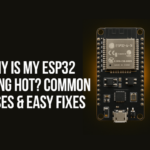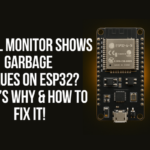Index
Introduction
Uploaded your sketch successfully, but the ESP32 just keeps restarting again and again? Or maybe it runs for a few seconds and then crashes? Don’t worry — you’re not alone. In this post, we’ll break down the most common reasons why your ESP32 keeps resetting or crashing after uploading code, and how you can fix it quickly.
What Does “Restarting” Look Like?
You’ll often see messages like these in the Serial Monitor:
ets Jun 8 2016 00:22:57 rst:0xc (SW_CPU_RESET),boot:0x13 (SPI_FAST_FLASH_BOOT) ...
Or sometimes you see:
Guru Meditation Error: Core 1 panic'ed (LoadProhibited). Exception was unhandled.
These are clear signs that something is going wrong after code upload.
Common Reasons Why Your ESP32 is Restarting or Crashing
1. Power Supply Issue
If you’re powering your ESP32 from a weak USB port or a bad cable, it may not be getting enough current — especially during Wi-Fi or Bluetooth startup.
Fix:
- Use a high-quality USB cable and connect to a proper USB 3.0 port.
- Try using a 5V 1A power supply (phone charger + USB cable).
2. Watchdog Timer Resets
ESP32 has watchdog timers that reset the chip if code gets stuck in a loop or takes too long in one task.
Fix:
- Make sure you use
delay()oryield()in long loops to prevent watchdog resets. - Avoid infinite while loops without breaks.
3. Faulty Peripherals or Sensors
If something connected to the GPIO pins is shorted or drawing too much power, the ESP32 might crash or enter a reboot loop.
Fix:
- Disconnect everything from GPIO pins and test with only USB connected.
- Reconnect peripherals one by one to find the culprit.
4. Code Consumes Too Much RAM
Memory overflows can lead to crashes, especially if you’re using large arrays, images, or web server libraries.
Fix:
- Use the
ESP.getFreeHeap()function to monitor RAM usage. - Optimize code: use
Stringcarefully, minimize global variables.
5. GPIO Conflicts During Boot
Certain pins on the ESP32 must be in specific states at boot time. Using them incorrectly can cause boot loops.
Fix: Avoid using these pins during startup:
- GPIO 0, 2, 15 – used for boot mode selection
- GPIO 6–11 – connected to flash memory internally
6. Exception or Panic Errors
Guru Meditation Errors or panic dumps usually mean a memory or code execution problem.
Fix:
- Recheck your code logic
- Use
Serial.print()debugging to find the crashing line - Simplify your code to isolate the problem
Quick Checklist to Fix Restarting Issues
| Check | What to Do |
|---|---|
| Power Supply | Use good USB cable / external 5V |
| Peripherals | Disconnect sensors & modules |
| Code | Avoid infinite loops, delays, large data |
| GPIO Pins | Don’t use 0, 2, 15 wrongly |
| Serial Monitor | Watch for crash messages |
| Flash Settings | Re-upload with correct board settings |
Bonus Tip: Use esp_reset_reason() in Code
Want to know why your ESP32 reset? Use this:
#include "esp_system.h"
void setup() {
Serial.begin(115200);
delay(1000);
Serial.println("Reset reason: ");
Serial.println(esp_reset_reason());
}
It will show messages like POWERON_RESET, SW_CPU_RESET, or DEEPSLEEP_RESET — helping you diagnose better.
Conclusion
Crashes and restart loops may look scary, but most of the time the fix is simple: clean power, clean code, and correct pin usage. If your ESP32 is crashing right after upload, don’t panic — use the tips above to track down the cause, one step at a time.


